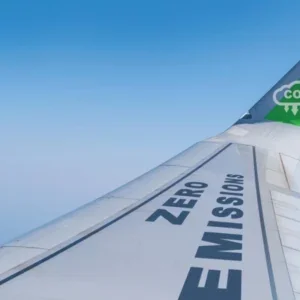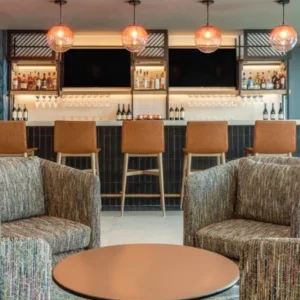
The past ten years have seen seismic changes in India. Every part of the economy, from the media to transport, telecoms to textiles, has seen major developments and disruption, largely due to the government’s determination to establish the country as a major digital power. The Digital India campaign was launched three years ago, and has since become the centrepiece of Prime Minister Narendra Modi’s vision for a contemporary, dynamic and innovative economy.
The resulting growth has firmly established the world’s largest democratic country as a global leader in tech and innovation.
The impact on the airports sector is just as marked. The Airports Authority of India reported in 2017 that the country’s airports handled over 254 million passengers in 2016, an increase of 20% over 2015.
Those figures confirmed India as the fifth-biggest market based on global rankings, overtaking Germany, and behind only the US, China, Japan and the UK. India’s airlines flew 117.18 million passengers in 2017 compared with 59.87 million in 2011. They registered an 18% growth over the 99.88 million passengers who flew in 2016.
That growth shows no signs of slowing, presenting the country’s airport operators with a genuine challenge to maintain and grow capacity. And this is a pressing issue: India’s biggest hubs are already operating at 70% of capacity, with New Delhi and Mumbai at more than 80%, according to a 2017 report by the Center for Asia Pacific Aviation.
Ominously, passenger numbers are likely to exceed capacity by 2022, the report said, confirming what most in the industry already know: long-term planning is needed to meet growing needs, and the solution cannot simply be limited to more bricks and mortar.
Star on the rise
Among this rapid expansion, Bengaluru’s Kempegowda International Airport stands out. Sitting at the heart of India’s tech revolution, Bengaluru has established itself among the preeminent digital cities in Asia, with major tech firms including Google, Cisco and SAP all having significant facilities in the city, employing thousands of bright young locals as well as many international expats.
Since it opened in 2008, the airport has become now the third-busiest in the country, serving a record 26.9 million passengers and 197,330 air traffic movements during FY 2017-18.
Kempegowda, which is run by Bangalore International Airport (BIAL), has been an integral part of the city’s rise to global status. The airport’s COO, Javed Malik, says his biggest challenges are twofold: keeping up with the enormous pace of growth in the short term, and investing in the right systems and processes to ensure the airport remains at the cutting edge in the long term.
“Our passenger numbers are rising very fast,” Malik says. “In fact, we’re the second-fastest-growing airport in the world [in terms of passenger growth]. That is great, but it does pose us quite a few questions. We have to ensure we keep up with that growth, and that means making sure we identify the short-term priorities and take a sensible long-term view.”
Smarter growth
Central to the long-term planning that Malik now leads is the concept of ‘bytes not bricks’. “The fact is we cannot always simply build our way out of a capacity problem,” he says. “It’s tempting to go down that route, and it’s what airports may have done in the past. But the real progress and innovation now lies in the technology that we deploy.”
The key pillar of this, he explains, is the new paperless biometric selfboarding technology, aimed at transforming the passenger experience and creating future-ready airports.
“We signed a deal with the Portuguese company Vision-Box to supply this system, and we think it will have a really significant impact on the way we serve our customers,” Malik adds.
Bangalore’s implementation of this technology would make it the first airport in India to have an end-toend solution for paperless air travel.
Malik says the goal of the programme is to simplify the journey by making it paperless from registration to boarding. Biometric technology uses facial recognition as passengers move through the airport, avoiding stops and the repeated presentation of boarding passes, passports and other physical identity documents.
Boarding passes now print and scan in just six seconds – a dramatic improvement on the previous average of 30 seconds. “It’s a huge improvement, and the impact on the customer experience and passenger flow is enormous.”
Smoother progress
In addition, in 2017 Malik introduced an automatic tray retrieval system (ATRS) to the airport, which helps to process passengers through screening far quicker. The installation of the ATRS was delivered in collaboration with L3 Macdonald Humfrey, a UK-headquartered technology developer, which led to the full introduction of the system in March 2018 following a trial run.
Trays, which can accommodate maximum-size cabin baggage, will be RFID-tagged and tracked from start to end, and laptops and laptop bags can be placed side by side in the same tray. A ‘reject line’ would be created for baggage containing suspicious items. These are marked on the touchscreen displayed in a remote screening room, with the images available to the physical search officer.
“We can now process more passengers in a secure and controlled environment, improving overall operational efficiency and enhancing safety and security. In addition, passengers benefit from a quicker passage through security checkpoints,” Malik explains.
Alongside that, he continues, “We’re able to share images of screening across the airport instantaneously, and that gives us a huge advantage over people who may be engaged in unlawful activity in the airport. The practice of collusion, in particular, will come under far greater scrutiny thanks to the technology that we’re able to bring to bear.”
None of this would work quite so well, the COO admits, without prioritising passenger needs – and again, technology provides the key to understanding what people want.
“We have a range of feedback tools available to us that help us get a sense of what our customers want. We have adopted SkyTrax and we’re developing an app to allow customers to give us instant feedback on what works in the airport and what doesn’t.”
Open for business
Of course, there’s no guarantee that these changes will prove successful. But whatever doesn’t work will be carefully noted and improved upon in time for the next milestone in the airport’s life: 2021, when the new Terminal 2 comes online.
The T2 project will be built in phases, with Phase 1 covering 255,000m². According to BIAL, the first phase of this terminal will cater to 25 million passengers every year.
The second phase will add to the airport’s capacity by another 20 million.
The construction of T2 is set to begin imminently, and is due to come on-stream around 18 months after the airport’s second runway goes into service in September 2019.
It all adds up to exciting times for BIAL, and Malik admits that the airport project is a beacon for similar projects, not only in India but across the world. “What we’re doing at Bangalore [Bengaluru] is unique, and it’s really important that we get it right.”
And the COO is clear that Bangalore remains a work in progress. The past two years have seen Malik and his team visit airports across the world to see how other fast-growing facilities have coped with the need to keep up with rapid expansion while shaping their long-term future.“We spend a lot of time looking at other airports,” he says, listing Qatar, Dubai, Schipol and San Francisco as particular inspirations. “The gold standard for all this of course is Singapore,” he says.
Human face of technology
Bangalore’s rise to prominence as a city has run parallel to the advent of the Digital India initiative, which has – unlike many grand government projects across the world – delivered some real benefits to the subcontinent.
The Modi government has wasted no time in promoting India as a destination for international companies, as well as encouraging domestic businesses to embrace technology and put innovation at the heart of everything they do via tax breaks, subsidies and direct investment.
But at Kempegowda, it is not simply a tech story. Malik says that providing a human face and personality to the airport experience is central to Bangalore’s strategy to be the best in India. “People don’t just want to be confronted with a wall of screens – they do need to see some friendly faces around the place.”
That’s why the airport has pioneered the use of ‘digi-buddies’ – trained attendants dotted around the terminal to help passengers who may find the straight-through digital process confusing or difficult. “It’s a difficult balance to strike with the interaction element,” Malik says.
“Passengers like to see real people and they want to be able to ask for help. At the same time, they don’t want to be intruded on or bothered too much. Judging by the feedback we’ve had so far, we have got the balance right.”
And he admits there are some innovations that might surprise the global traveller who is tired after a long trip and dreading the wait to go through security. “We decided to bring in roaming ‘human jukeboxes’: the idea is that we offer to play a range of songs for passengers while they wait in order to make the whole experience a little less wearing and a bit more fun.”
The BIAL timeline
1994: Idea to set up India’s first private airport in Bengaluru.
1999: Government of India (GOI) awards the project to Siemens-led consortium including L&T and Unique Zurich Airport, with 40:17:17 equity. The GOK and AAI are each to hold 13% equity.
2001: BIAL is incorporated.
2004: BIAL signs public privatepartnership agreement with GOI, becoming India’s first private airport.
2005: Land Lease Deed between GOI and BIAL is signed.
2006: Construction of the airport commences.
2007: Commissioning and trials begin.
2008: Commences operation from 24 May. Air India Flight 609 from Mumbai is the first flight to land – a day before opening, on 23 May.
2010: BIAL decides to expand Terminal 1.
2012: Commencement of Terminal expansion as airport crosses the 50-million passengers mark.
2013: Renamed Kempegowda International Airport.
2014: Inauguration of expanded terminal.
2015: Planning of Terminal 2 and New South Parallel Runway (NSPR).
2016: Airport welcomes 100-millionth passenger – another benchmark.
2017: L&T is awarded contract to construct NSPR. Fairfax India Holding buys 48% stake in BIAL from GVK as it becomes the first airport in India to launch a helicopter taxi service.
2018: Fairfax India Holding increases its holding to 54% by acquiring an additional 6% stake from Siemens Project Ventures. It closes FY 2017-18 with a record 26.9 million passengers and 197,330 air traffic movements, also welcoming its 150-millionth passenger.
Source: BIAL






